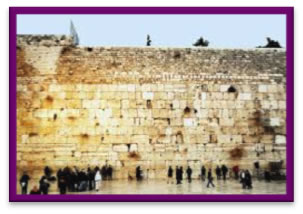|
In the First Reading, an angel shows Ezekiel the Temple in a vision. In the vision, the Temple is the source of life-giving water that sustains all creatures that come to it.
The Temple that Ezekiel saw has been destroyed for a long time. All that is left now of the last rebuilding of the Temple is one wall, the Western Wall in Jerusalem. It looks like this:

People come from all over the world to pray at this Wall. They put their heads down on those big stones, and the stones bring up out of their hearts their deepest sorrows and their most bitter tears. Even the stone remnants of the Temple are life-giving for them.
In the Second Reading, Paul tells us that each one of us is the temple of God. And in the Gospel reading, Jesus says that the true Temple is his body.
So, what is the Temple then?
The Jews have put up a sign near the Wall in Jerusalem to explain the Wall’s sanctity. Their sign finishes this way: “God promised that his Spirit would never leave these stones. This is a holy place.” What makes the Wall holy, and what made the old stone Temple life-giving, is that God’s Spirit was and is in it, as God promised Solomon it would be. (I Kings 9:3)
That is why Christ’s body is a Temple, too. In Christ, the Spirit of God indwells Christ’s human body. The presence of that Spirit is what makes Christ’s body the Temple. What was there in the old Temple of stones has a new and more powerful incarnation in the body of Christ, and it gives eternal life to all those who come to it.
God’s Holy Spirit comes to indwell in every person who comes to faith, too. And so every person of faith is also somehow the Temple of the Lord.
But notice that it is one and the same Spirit that is in each person of faith. And so all believers, taken together as the Church, make just one Temple, indwelt by the Holy Spirit. And that is why the Church is the body of Christ, which is the one true, life-giving Temple.
God’s Spirit will never leave this Temple.
Eleonore Stump
|